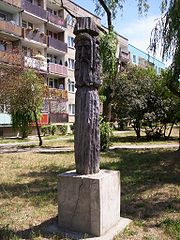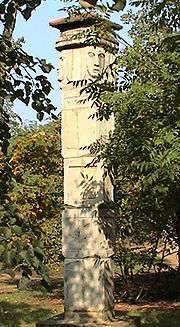Svantevit
- Svantevit
-
Svantovít

Statut(totem) de Svantovit (Triglav de Svarog) à Głogówě,
Pologne

Totem à Otrebusy, Pologne
Svantovit (Świętowit en polonais, Svantevit en danois), serait le dieu de la guerre dans la mythologie slave. La seule chose que nous sachions de lui avec certitude est ce qu'en rapporte un chroniqueur allemand, Helmold von Bosau, dans sa Chronica slavorum : divinité des Wendes, des Slaves occidentaux, ce dieu à quatre têtes est adoré au Kap Arkona et mentionné comme étant le plus important de tous pour ces tribus. Son sanctuaire, à Arkona, fut détruit par Valdemar Ier de Danemark en 1168.
Certains associent ce dieu des Slaves occidentaux au Vélès des Russes païens ou à Weiha dans les régions intérieures des pays slaves.
Svjatevit serait l'une des trois faces du Triglav et aurait été principalement honoré dans les pays baltes. En son honneur, on aurait célébré, chaque année, une grande fête à la fin de la moisson.
Voir aussi
Catégorie : Divinité slave
Wikimedia Foundation.
2010.
Contenu soumis à la licence CC-BY-SA. Source : Article Svantevit de Wikipédia en français (auteurs)
Regardez d'autres dictionnaires:
Svantevit — Der vierköpfige Svantovit als künstlerische Nachbildung am Kap Arkona Svantovit (auch Svantevit, Sveti Vid, Swantewit, Svetovit, Svatovit, Świętowit oder Святовит) ist eine slawische Gottheit. Er war der Kriegsgott und die oberste Gottheit der… … Deutsch Wikipedia
Hotel Svantevit (FUP 10/ 2014) — (Юлиусрух,Германия) Категория отеля: Адрес: Wittower Straße 9 10, 18556 Юли … Каталог отелей
Slavic mythology — is the mythological aspect of the polytheistic religion that was practised by the Slavs before Christianisation. The religion possesses many common traits with other religions descended from the Proto Indo European religion. Zbruch Idol. Contents … Wikipedia
Mitología eslava — La mitología eslava es la expresión del sistema de creencias cosmológicas y religiosas que los antiguos pueblos eslavos tenían antes de que adoptaran la religión cristiana. Se piensa que pudo desarrollar a lo largo de 3000 años y que algunas… … Wikipedia Español
Svetovid — Sventevith, Svetovid, Suvid, Svantevit, Svantovit, Swantovít, Sventovit, Zvantevith, Świętowit, Światowid, Sutvid, Vid. and, incorrectly, Światowit , is the Slavic deity of war, fertility and abundance. Sometimes referred to as Beli (or Byali)… … Wikipedia
Zbruch Idol — The Zbruch Idol ( pl. Światowid ze Zbrucza, ru. Збручский идол) is a 9th century sculpturepl icon cite journal | author =Roman Kozłowski | year =1964 | month = | title =Badania technologiczne posągu Światowida z Muzeum Archeologicznego w Krakowie … Wikipedia
Mythologie Slave — La mythologie slave désigne le système de croyances cosmologiques et religieuses des anciens peuples slaves avant leur évangélisation. Elle a évolué pendant plus de 3000 ans. Ses éléments proviennent selon les hypothèses du néolithique, voir peut … Wikipédia en Français
Mythologie slave — La mythologie slave désigne le système de croyances cosmologiques et religieuses des anciens peuples slaves avant leur évangélisation. Elle a évolué pendant plus de 3000 ans. Ses éléments proviennent selon les hypothèses du Néolithique, voire… … Wikipédia en Français
Rani (Slavic tribe) — The Rani or Rujani ( de. Ranen, Rujanen ) were a West Slavic tribe based on the island of Rugia and the southwestern mainland across the Strelasund in what is today northeastern Germany and 1500 years ago was the territory of the Rugi. The Rani… … Wikipedia
Jaromarsburg — Wall der Jaromarsburg Die Jaromarsburg war vom 6. bis zum 12. Jahrhundert eine dem Gott Svantovit gewidmete Kultstätte des slawischen Stammes der Ranen. An der Nordostspitze bei Kap Arkona auf der Insel Rügen gelegen, war sie von zwei Seiten… … Deutsch Wikipedia




